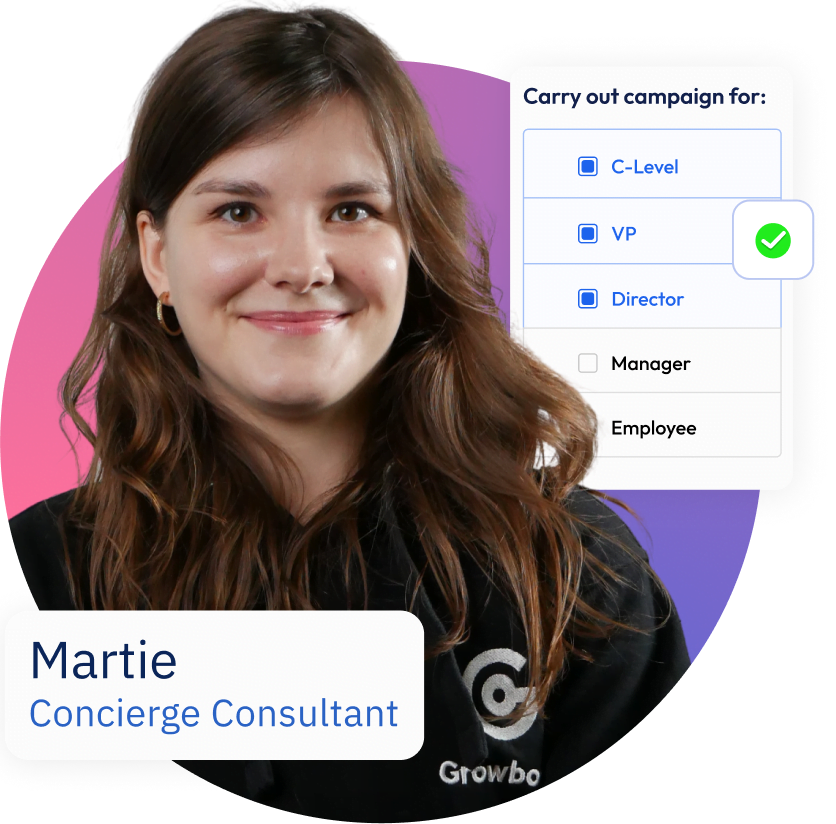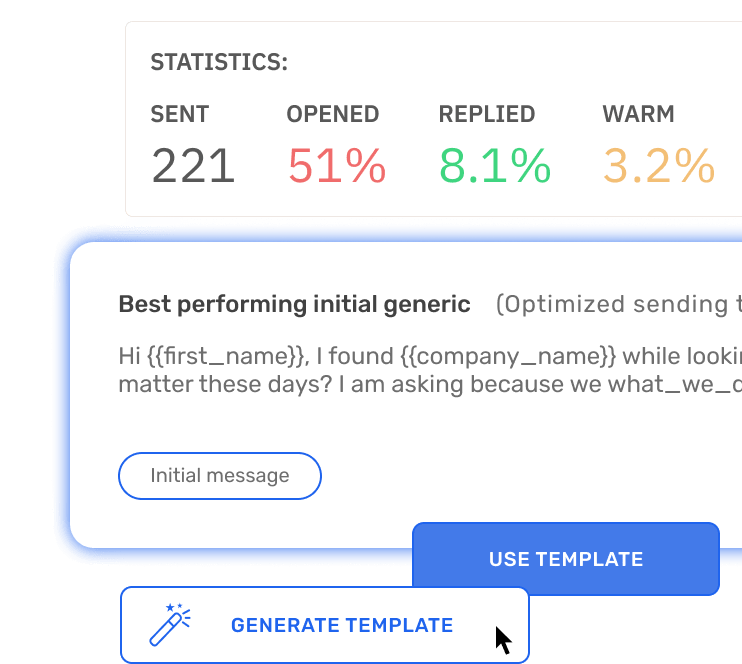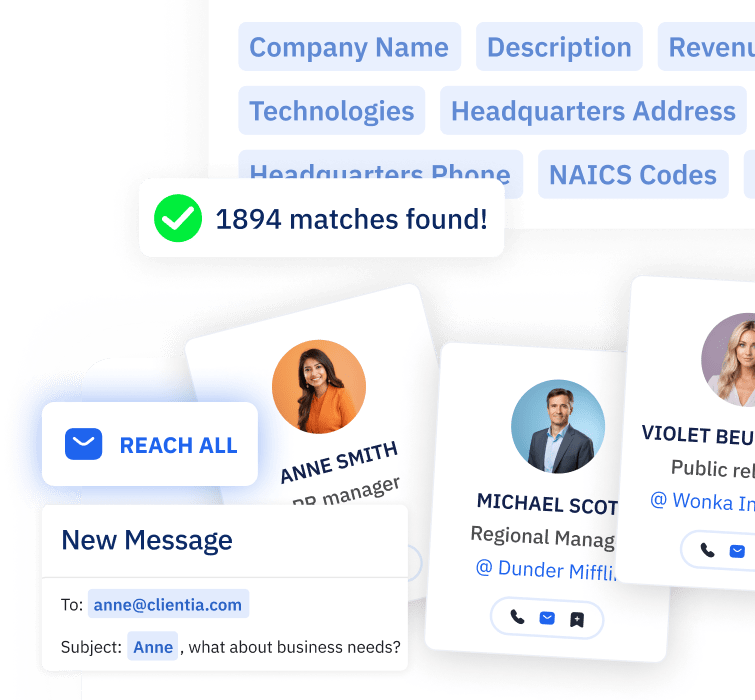In the highly competitive world of B2B sales, prospecting is a fundamental process that sets the stage for success. It involves identifying and engaging with potential customers, nurturing relationships, and ultimately converting them into qualified leads.
A well-executed sales prospecting strategy enables sales reps to fill their sales pipeline with high-quality prospects and increase their chances of closing deals.
In this article, we will explore the ins and outs of B2B sales prospecting, including different methods, strategies, and tools to help you achieve remarkable results within your B2B company.
So without further ado, let’s dive in and learn all the secrets of a successful prospecting!
TL;DR
- The goal of B2B sales prospecting is to identify and engage with potential buyers to generate sales qualified leads.
- It consists of three phases: research, qualification, and outreach and one additional phrase which should be a constant element in your prospecting strategy: iteration.
- Sales prospects are prospective customers who fit your ideal customer profile, while leads are prospects who have shown higher levels of interest and engagement.
- Different B2B prospecting methods are inbound and content marketing, outbound prospecting, cold calling, and social selling.
- Effective B2B prospecting strategies include defining an ideal customer profile, creating buyer personas, implementing a structured prospecting process, personalizing outreach, following up and nurturing leads, utilizing prospecting automation tools, and asking for referrals.
- Useful tools for B2B prospecting include sales enablement platforms, CRM software, email marketing tools, and LinkedIn Sales Navigator.
- Key metrics to measure B2B sales prospecting success include qualified leads generated, conversion rate, sales cycle length, and revenue generated.
- Continuous evaluation and optimization of your efforts to target prospects are essential for sustainable growth and success in B2B sales.
- The process of B2B prospecting can be automated using a powerful tool like Growbots. Try it for free and gain access to a database of over 170M worldwide contacts.
What is B2B sales prospecting?
B2B sales prospecting refers to a systematic process of identifying and engaging with potential customers or organizations that match your buyer persona and have the highest probability of benefiting from your product or service.
It is the first step of the sales process and plays a crucial role in establishing a meaningful connection with your target audience.
By prospecting effectively, sales professionals can identify qualified leads and prioritize their sales efforts towards those who are most likely to convert.
B2B sales prospecting can be broken down into three main phases.
- Research which plays a key role in identifying potential leads who may have an interest in your offerings.
- Qualification which is crucial in prioritizing prospects who align well with your business and are more likely to convert into satisfied customers.
- And the outreach phase (e.g. using cold emailing) which involves connecting with these leads and laying the groundwork for closing deals.
One additional phase includes constant iteration which we will cover in more detail later in the article.
The main objective is to target people who match your buyer persona, qualify them appropriately, and establish strong relationships with them that can ultimately lead to successful conversions.
It’s worth noting that the specific approach to sales prospecting may vary depending on the nature of your business and the particular market you operate in.
For instance, the manner in which you qualify leads may differ.
Some sales professionals prefer to qualify prospects before initiating outreach, while others opt for cold calling as the initial approach.
What is the difference between sales prospects and leads?
While you might have heard the terms “sales prospects” and “leads” often used interchangeably, they actually have distinct meanings in the B2B sales world. Understanding the difference is important if you want to establish an effective prospecting process.
Sales prospects are prospective customers or organizations that fit your ideal customer profile and have expressed some level of interest or need for your product or service.
They have the potential to become your customers but have not yet entered the sales process.
Leads, on the other hand, are sales prospects who have taken specific actions that indicate a higher level of interest and engagement, such as requesting a demo, downloading a whitepaper, or signing up for a newsletter.
Leads are typically further along in the sales funnel and are considered warmer prospects.
Differentiating between sales prospects and leads allows sales representatives to prioritize their efforts and focus on nurturing and converting the most promising opportunities.
Read also: Best sales books for SaaS businesses you must read
Different B2B prospecting methods
B2B sales prospecting techniques are the strategic and proactive approaches used by sales professionals to actively seek out and connect with new leads or engage with existing ones.
There are several prospecting methods that a sales team can leverage to identify and reach people who might be interested in your product or service.
Some popular methods include:
Inbound marketing
By creating valuable content and optimizing it for search engines, inbound marketing can attract potential B2B prospects to your website.
Through techniques such as content marketing, search engine optimization (SEO), and lead magnets, inbound marketing can generate new business for your company through leads and prospects who have expressed interest in your industry or solution.
leave no lead unexplored
Every potential client within reach
- 180m+ contacts
- CRM integrations
- 23 Prospect filters
- 15 Company filters
Outbound prospecting
This method involves proactively reaching out to potential prospects through channels such as email or direct mail.
Outbound prospecting allows sales reps to reach target accounts or individuals and initiate conversations with potential clients who may not have been aware of your product or service before.
Since both scale and precise targeting are crucial for success in automated prospecting, utilizing outbound automation tools can help you with establishing an effective prospecting strategy.
An example of an outbound sales platform that enables automation is Growbots. With Growbots, businesses can streamline their outreach process, saving time and increasing productivity.
The tool enables automated personalized email campaigns, allowing sales teams to reach a larger audience while maintaining a personalized touch.
The platform’s advanced targeting and segmentation capabilities ensure that messages are delivered to the right prospects at the right time, maximizing the chances of engagement.
By automating repetitive tasks such as building the follow up sequences and scheduling, Growbots enables sales professionals to focus on building relationships and closing deals.
Cold calling
Cold calling is a traditional method of prospecting which involves reaching out to potential prospects by phone, introducing your product or service, and gauging their interest.
Cold calling requires great communication skills and a well-researched approach to make a meaningful connection with the prospect.
In spite of being often viewed as the worst part of sales reps’ jobs, cold calling remains one of the most effective ways to prospect B2B clients.
Social selling
With the rise of social media platforms, social selling has become one of the most essential prospecting strategies.
Sales reps can leverage platforms like LinkedIn to build relationships, share valuable content, and engage with potential prospects in a more personalized and targeted manner.
Read also: The best practices for sales reps
B2B prospecting strategies to use
Besides using the right prospecting tools (we share a list of the best ones on the market later in this article), it’s crucial to implement effective strategies that align with your sales and marketing goals in order to maximize your efforts while looking for prospects.
Here are some proven B2B prospecting strategies:
1. Defining your ideal customer profile
Defining the ideal customer profile is a crucial step in effective B2B prospecting.
The process of establishing an ICP (ideal customer profile) involves identifying prospects who not only desire the product or service but also possess the intent and capacity to make key purchase decisions. Historical customer data stored in a CRM provides valuable insights for this process.
Why is it important?
By establishing a clear target market and audience, you can save valuable time and resources that might otherwise be wasted on unqualified leads.
Analyzing factors such as order value, conversion rates across industries and personas, sales cycles, and common attributes helps create a comprehensive picture of your target audience.
Additionally, understanding pain points and buying behaviors further refines prospecting efforts by focusing on those who are most likely to benefit from the solution.
2. Create buyer personas
Besides an ICP, you should develop detailed profiles of your ideal customers, including demographic information, job titles, challenges, and motivations.
It will help you develop messaging and approaches that resonate with your target audience.
The more information gathered, the better equipped you or your sales team are to tailor your B2B prospecting strategies for optimal results.
The distinction between an Ideal Customer Profile (ICP) and a buyer persona lies in their focus.
An ICP represents the ideal type of business you aim to sell to, while a persona provides a comprehensive description of individuals who can gain value from your offerings.
In many cases, a persona will embody a particular buyer or decision-maker within the ICP you define.
3. Implement a structured prospecting process…
Establish a step-by-step framework for prospecting that outlines the activities, channels, lead qualification criteria, and touchpoints involved in reaching out to potential customers.
Regardless of how skilled your sales team is, having a streamlined framework is important as it ensures consistency and allows for better tracking and measurement of the efforts to find leads.
You can tailor the process to meet the unique needs of each customer, incorporating feedback from prospects. Simplicity is key, but be sure to include vital steps like customer onboarding, product demonstrations, and identifying growth opportunities.
As customer needs evolve and technology advances, you should remember to regularly review and refine your process.
4. …and iterate on it
To achieve consistent success in prospecting, it is not only crucial to set up a proper prospecting process as we mentioned above but also to continuously improve and refine it.
Tracking, learning from, and adapting your approach to prospecting is essential in finding a rhythm that consistently delivers results.
Take diligent notes throughout each prospecting interaction, assessing the value generated and identifying any time-wasting activities.
After engaging with prospects, evaluate your performance in uncovering challenges, establishing goals, confirming budgets, understanding decision-making processes, gauging consequences of inaction, and identifying potential results of success.
Through self-reflection and analysis, you can enhance your sales prospecting techniques, ensuring continuous improvement and increasing your chances of achieving positive outcomes in the future.
5. Remember about personalization
When it comes to the outreach phase of your prospecting activities, using personalization is not just a nice-to-have; it’s a necessity.
Instead of sending generic emails to your entire lead list, take the time to segment your audience and create custom messages for each group.
You can go even further by incorporating personalization elements such as the recipient’s name, company, or specific pain points they may be facing. Although it may require additional effort, personalized messages yield higher response rates, leading to more closed deals.
By making your outreach feel like a one-on-one conversation, you establish a stronger connection with your prospects.
However, it’s essential to remember that personalization alone cannot compensate for relevance. Before crafting the perfect email or making a well-timed call, ensure that your product or service aligns with your target’s needs.
Irrelevant messages, no matter how personalized, are missed opportunities. Research your prospects thoroughly and get it right from the start to make every interaction with them meaningful and valuable.
Reach More with Less Effort
Connect with Potential Clients at scale
- AI message generator
- E-mail verification
- Multichannel sequences
- A/B testing
6. Follow up and nurture leads
In the world of B2B sales prospecting, one of the aspects that cannot be overlooked is the need for effective follow-up.
It is a common mistake for salespeople to neglect following up with their leads, assuming lack of immediate interest means disinterest altogether.
However, it is important to recognize that potential clients are often occupied, prone to distractions, and may simply forget. Regardless of a previous lengthy and productive call, a few days can make a difference.
This emphasizes the necessity of establishing a robust follow-up plan. Reaching out to clients multiple times, even those who may have gone cold, is crucial.
The general rule of thumb suggests following up at least five times, but in some cases, persistence may require ten or more attempts before eliciting a response.
Balancing between being too pushy and giving up too easily is key. A well-crafted follow-up strategy, incorporating a combination of emails, calls, and preparedness for the next conversation, is essential to ensure maximum success in the prospecting process.
Implementing follow-up templates can bring consistency to your approach, leading to better outcomes.
Remember, a diligent follow-up plan can be the catalyst for converting interested leads into satisfied customers.
7. Prospecting automation
Another B2B prospecting strategy that is a game-changer is to utilize a prospecting automation tool.
Sales reps spend around 50% of their time on prospecting. Knowing this, automating this process in your company is a crucial step in order to maximize your time and work efficiently, increasing productivity and the potential for higher deal closures.
Growbots is a great example of a platform like that. By combining prospecting, email automation, and contact data in one solution, it streamlines the entire prospecting process. Manual tasks such as searching for contact data are eliminated, saving you valuable time.
Growbots offers a comprehensive B2B database with over 170M+ contacts which can be easily sliced and diced using filtering criteria to make sure that you really are targeting the right audience.
8. Try different sources like asking for referrals
Asking for referrals can be a powerful strategy in lead generation and boosting your prospecting efforts. According to a recent survey by HubSpot, 66% of sales professionals believe that referrals from existing customers offer the best leads.
When you ask for referrals, you tap into a wider network of contacts who are more likely to be receptive to your solution.
The recommendation from an existing customer serves as a valuable endorsement, making the referred leads more inclined to consider your offering.
When reaching out to these leads, mentioning the customer who provided the referral creates an instant connection and helps establish rapport.
By proactively seeking referrals, you can expand your network with warmer contacts and gain a crucial advantage in your prospecting activities.
Read also: Where can you find free email address directories?
Useful tools for B2B prospecting
There are various tools available on the market that can significantly enhance your business to business prospecting. Below, we share the most popular categories of such tools that you can utilize for lead generation:
Sales enablement platforms
Platforms for sales enablement provide sales teams with the necessary content, training, and resources to effectively engage with prospects at each stage of the sales process.
CRM software
Customer Relationship Management (CRM) software helps sales reps track and manage their interactions with prospects, ensuring no potential opportunity falls through the cracks.
Email marketing tools
Tools like Mailchimp, HubSpot, or Sendinblue enable sales professionals to automate personalized email campaigns, track engagement, and measure the effectiveness of their outreach efforts.
LinkedIn Sales Navigator
LinkedIn’s Sales Navigator is a powerful tool for social selling and prospecting. It provides advanced search filters, lead recommendations, and personalized messaging capabilities to help sales reps connect with potential customers on the platform.
Read also: The Essential Guide To Sales Engagement Platforms
Seek, pick, and reach
Connect with your potential customers
- 180m+ contacts
- Advanced filtering
- Multichannel sequences
- CRM integrations
How to measure B2B sales prospecting success
To evaluate the effectiveness of your strategy to find new prospects, you need to track and measure key metrics. We recommend focusing on the following ones:
Conversion rate
You should also calculate the percentage of leads that progress through your sales pipeline and eventually convert into paying customers. This metric reflects the efficiency and effectiveness of your prospecting actions.
Sales cycle length
This measurement helps you track the average time it takes for a prospect to move through the entire sales process, from initial contact to closing the deal. Shortening the sales cycle can lead to increased revenue and improved overall performance.
Revenue generated
Ultimately, the revenue generated from your prospecting efforts is a key indicator of success. Measure the monetary value of closed deals that originated from your prospecting activities to assess your overall return on investment.
Conclusions
Effective B2B sales prospecting is a crucial component of building a successful sales pipeline.
By implementing the right prospecting methods, strategies, and tools, you can identify and engage with qualified prospects, nurture relationships, and increase your chances of converting them into loyal customers.
Remember to continually evaluate and optimize your prospecting efforts based on key metrics to achieve sustainable growth and success in your B2B sales endeavors.

Kacper Zwarzany
Sales Development Expert at Growbots
























